Cities: Skylines, a New Boring, Lifeless Take on the City Builder
writing · · 8 min readSome time ago, I wrote about 2013’s SimCity, a disappointing entry in a beloved city-building franchise. 2015 saw the release of Paradox Interactive’s Cities: Skylines, a brand new city-builder from a much smaller studio. Much hyped and heavily anticipated, the game has been very well received by the gaming community. Many have praised it as “the SimCity we wanted” and “the game that shows AAA studios how it’s done.”
My opinion is more mixed. Though Skylines is an impressive technical achievement that gives players some nice tools to build creative cities with, its gameplay and depth of simulation are disappointingly shallow. It is passable as a city builder, but it is not a worthy followup to the challenging and interesting gameplay found in the older SimCity games.
As a game, Skylines isn’t even particularly difficult. The early game, with a small, low-density town, offers the slight challenge of balancing a tight budget with limited resources. But once the city has grown and the financial woes are long gone, there’s hardly any social, environmental, or financial problems to encounter, with the possible exception of traffic gridlock. (More on this later.) As in SimCity, players are left to build their cities indefinitely with no endgame in sight. Except this time, there are no challenges, either.
This is in part due to the game’s oversimplifications. For example, Skylines has no concept of social class. Residential, commercial, and industrial buildings can “upgrade” to higher levels and hold more residents and jobs, and since these upgrades happen with higher education and access to more city services, it is implied that upgraded buildings are wealthier. But there are no differences between residents and employers from higher and lower levels. They are functionally the same, and the game never makes any distinctions between them. Unlike SimCity, one cannot set different tax rates and policies for higher and lower-level developments. The upgrade level is merely a shorthand for density.
The classless society found in Skylines leaves much to be desired in terms of simulation and gameplay depth. Gone are the differing needs of SimCity’s poor and wealthy residents, the unique character of each individual neighborhood, and the challenge of satisfying a demanding high-wealth population. Instead, all residents have the same needs, work and shop at the same businesses, and live in the little boxes on the hillside that all look just the same.
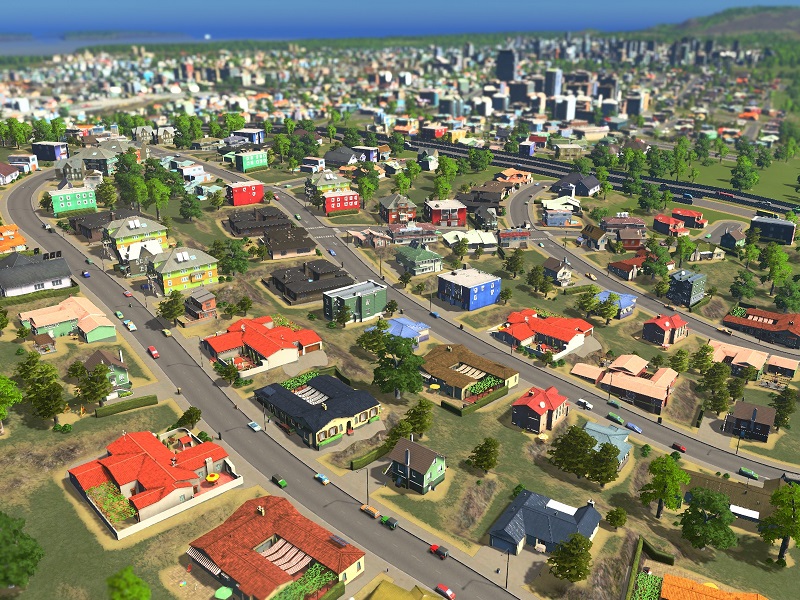
Instead, all residents have the same needs, work and shop at the same businesses, and live in the little boxes on the hillside that all look just the same.
In a callback to Paradox’s Cities in Motion series, public transportation features heavily in Skylines, with the ability to draw individual bus and train lines. Indeed, much of the hundreds of hours I’ve poured into the game has been spent perfecting my transit networks. But despite this level of detail, the transit mechanics also feel shallow. At one point, I eliminated my city’s entire heavily-used public transit system, expecting some kind of carmageddon to result. Instead, there was a barely perceptible increase in traffic congestion, and the city functioned just as well as it did with its transit. Meanwhile, buses and trains are a fixed cost no matter how many of them you run, so there’s no reason, besides congestion, to deploy them efficiently.
Trains are especially frustrating to work with. The game features heavy rail, surface tram, and subway lines with switches and tweakable grade separations, but the stations for both networks disallow crossovers (think Metro Center on the Washington Metro) and must be placed at specific elevations. In a game that’s necessarily smaller-scale than a real city, this results in maddeningly complicated, space-wasting station configurations where multiple lines meet. The most obvious solution is to have all trains share the same set of platforms, which inevitably leads to congestion if more than two lines share the same station. The one station available for heavy rail is also a massive waste of space, a behemoth of a terminal surrounded by a sea of parking. It’s cute as a grand gateway for tourists, but renders the mode useless for intra-city transportation.
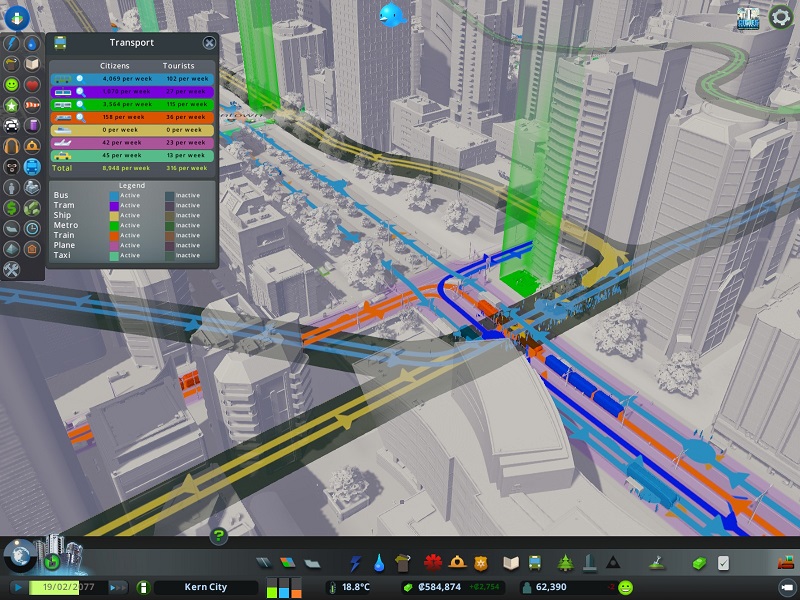
In a game that’s necessarily smaller-scale than a real city, this results in maddeningly complicated, space-wasting station configurations where multiple lines meet.
Contrast these needlessly irritating limitations with SimCity 4. Transfer stations are as easy as running two subway lines under the same station tile, or laying multiple rail lines next to the same passenger station. The passenger station is reasonably-sized, and a park-and-ride garage can be built separately. And while Skylines goes to great lengths to simulate three different kinds of rail transportation, it offers no means to interconnect them. One cannot take a subway above ground or bury a light rail line, as happens all the time in the real world. Even SimCity 4: Rush Hour featured a special transition ramp between its elevated rail and subway systems.
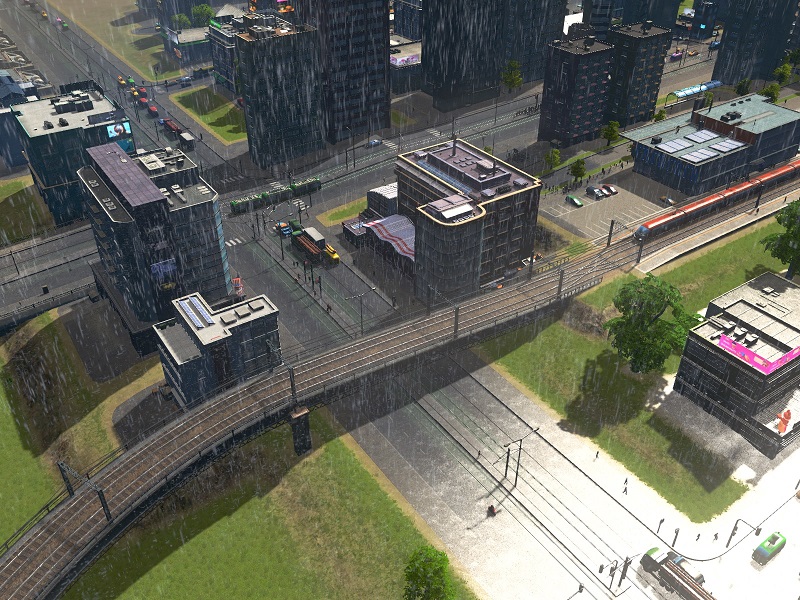
And while Skylines goes to great lengths to simulate three different kinds of rail transportation, it offers no means to interconnect them.
In a bizarre dichotomy, where Skylines doesn’t cut corners and oversimplify, it often simulates to an obsessive level of detail. This leads to some awkward mechanics and poorly conceived gameplay. For example, ridiculously, solar power plants cease producing power at night. There is therefore no incentive to either use them or turn on the optional day-night cycle.
Industrial zones can be reserved for specialized industries, some of which require depletable resources found only in specific areas of the map. Similarly, the “After Dark” expansion pack adds special tourism zones. But without strong incentives to make use of these specialized zones, I almost never placed them. Some specialized industries produce no pollution, unlike regular industry, but they produce so few jobs that they are inefficient wastes of space. Tourist buildings are little different from normal commercial buildings, except that they produce less jobs and, supposedly, attract more tourists. In practice, the tourist data view told me that tourists were widely distributed among various commercial districts, irrespective of the presence of tourist buildings.
More generally, real city governments are not concerned with shrinking petroleum reserves. Depletable resources belong in Civilization, not a city simulation game. Real city governments are quite concerned with boosting tourism, so tourism being just another type of commercial zone is disappointing. A city simulator needs to emphasize tourism as a way to generate significant tax revenues, not just a bunch of commercial buildings that look slightly different and pull in negligible numbers of visitors.
Skylines has also become legendary for its meticulous traffic simulation, and a substantial portion of the Skylines Reddit community is devoted to banishing traffic woes with titanic freeway interchanges. Like 2013’s SimCity, the game uses an “agent system,” which means it spawns individual vehicles and pedestrians to represent city services and commuting residents. Thus, every vehicle in the city is persistent, and the road network must be carefully designed to avoid gridlock. Congestion not only affects quality of life but also paralyzes waste collection, road maintenance, emergency services, and other city functions.
Though nice in theory, in practice, the agent system brutally punishes players for suboptimal road configurations, and much of the mid and late game revolves around resolving the inevitable traffic jams. And with road simulation, Skylines once again oversimplifies, causing needless frustration. On multi-lane roads, vehicles use destination positioning religiously, taking the left lane to turn left, the center lane to continue straight, and the right lane to turn right, and so forth, even on highways. Without careful planning, this often leads to long backups of dozens of vehicles in a single lane.
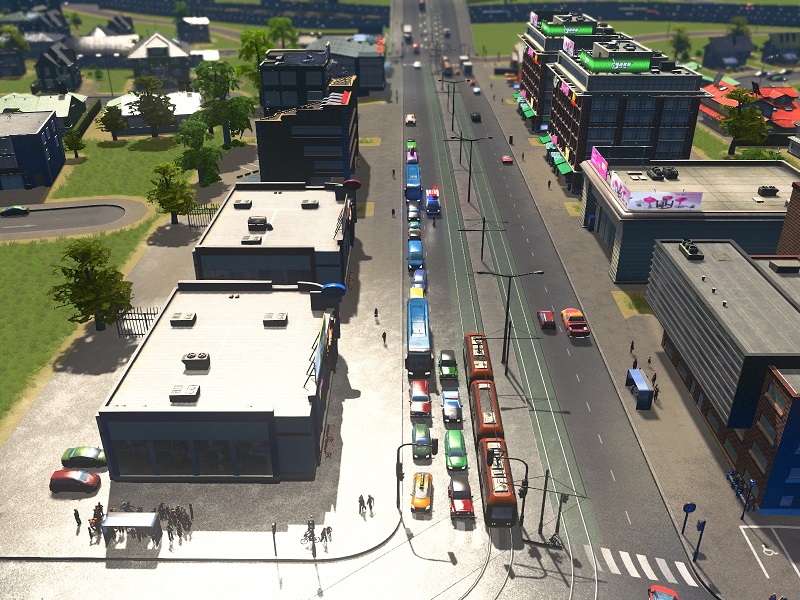
Without careful planning, this often leads to long backups of dozens of vehicles in a single lane.
And yet, Skylines grants no control over the traffic signal timings, no ability to add turning and slip lanes, or other such devices that real traffic engineers use. There is a dedicated bus lane for avenues, but it is curbside only, and other vehicles can use it to make turns. While features like these are probably too deep for a city-building game, forcing the player to tackle a full-fledged traffic simulation without them is downright infuriating, and turns “traffic management” in Skylines into a frustrating process of gaming the simplistic lane positioning mechanics.
As with SimCity, Skylines’ agent system has been praised as an innovative approximation of a real functioning city. But Skylines still simulates a smaller-scale city with a population much smaller than would be found in reality, so it is unclear what the value of the agent simulation is. Instead of making the city feel more lifelike, it only creates gratuitous difficulty. And that so much of the game is focused on moving around as many vehicles as possible suggests a sad, narrow-minded conception of the city, directly at odds with sociologist Lewis Mumford’s famous quote:
The city exists not for the constant passage of motorcars, but for the care and culture of men.
SimCity 4 got the general city-building concept right and kept its small aspects simple, which is where the community stepped in with mods to add new transportation options, additional buildings, and more city services. But Cities: Skylines opts for gameplay that is incomplete at its core, by omitting crucial features like social classes, progressive and regressive tax policies, and neighborhoods with distinctive character, and attempts to fill the void with obsessive, unnecessarily complicated simulation of minor details, such as traffic flow and commercial and industrial “specializations.”
This is a recurring theme in the game’s expansion packs, which are horribly overpriced for the limited value they add. After Dark and Snowfall introduce some useful transportation options, but are padded with otherwise useless content, such as tourism and leisure zoning, new heating and road maintenance mechanics for (permanent) winter weather, and even public saunas. The latest one, Natural Disasters, adds the titular eye-popping, doomsday scenarios, but does nothing to cure Skylines’ fundamental shortcomings.
SimCity was cool because the cities were dynamic, constantly evolving new neighborhoods to explore and new challenges to tackle. It taught players a little about the realities of urban governance. The art style was also incredibly well done, perfectly capturing the gritty reality of the American inner city. Skylines is a technically impressive sandbox with neat features for building things, like freeform roads, freeform terrain, and intricate waterworks mechanics, but its gleaming cities have little to offer beyond what you direct them to do. Devoid of any meaningful social or economic dynamic, the cities in Cities: Skylines feel about as “real” as the game’s brightly colored, gaudy, plastic-like buildings and vehicles.
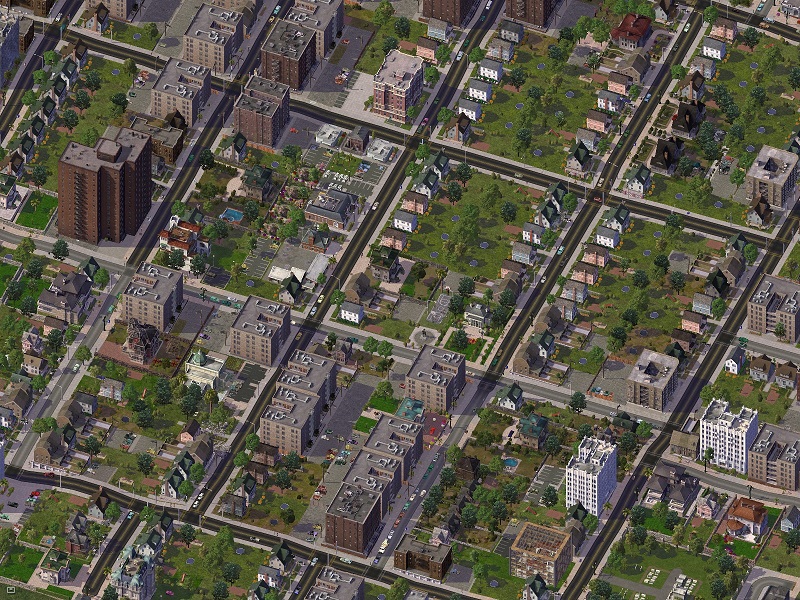
The art style was also incredibly well done, perfectly capturing the gritty reality of the American inner city.
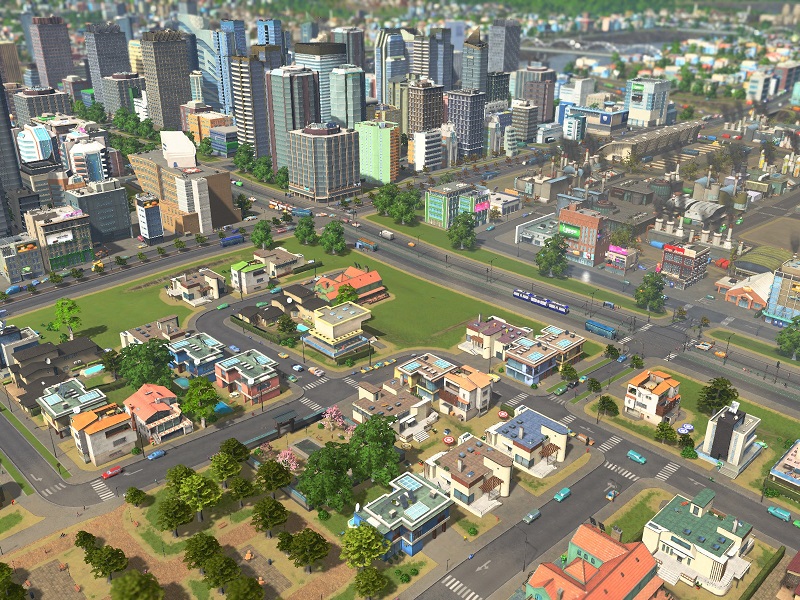
Devoid of any meaningful social or economic dynamic, the cities in Cities: Skylines feel about as “real” as the game’s brightly colored, gaudy, plastic-like buildings and vehicles.
As transit consultant Jarrett Walker pointed out in his reflections on the original SimCity, city-building games have the potential to instill concepts and ideas in a whole generation of geeks. I am thankful for the vibrant, animated world that SimCity 4 showed me. If Cities: Skylines is “the new standard in city building games” as Travis Huinker of Gaming Nexus put it, then today’s computer geeks are getting shortchanged by a triumph of spectacle over substance. Skylines is a tale told by an idiot, full of sound and fury, signifying nothing.